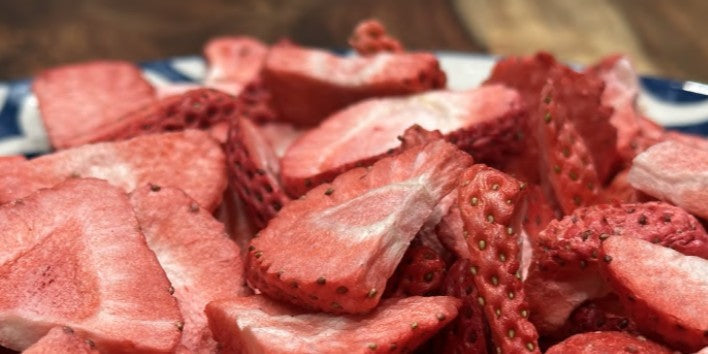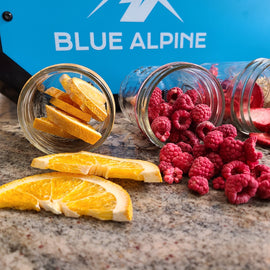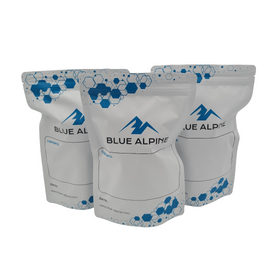Fruits, Berries, and Melons
Your Complete Freeze Dryer Guide
Blue Alpine's freeze dryers have endless capabilities. They provide for you the ability to have custom pressure and temperature settings as well as a few custom pre-sets to make starting out easy. These freeze dryers make it possible to freeze dry fruits, candies, meats, and more! But you may be wondering, "How do I know what settings to use?" Here, we've provided you with a generic guide to help you freeze dry a variety of foods, as well as a few detailed recipes for common fruits, berries, and melons.
General Freeze Dryer Settings?
The first thing you need to know when customizing your freeze dryer for a variety of foods is understanding what each basic setting is, and how they affect your cycle. While using Blue Alpine's freeze dryers, you will find 4 basic settings that you can customize. They are the Freeze Time, Dry Time, Dry Temp, and Pressure. Each of these settings can be pretty self explanatory, however, it's good to have an explanation for each:
Freeze Time: The default time for the freeze cycle for fruit is 9 hours. This generally provides sufficient time to completely freeze your food before the dry cycle. However, larger batches tend to need more time, and smaller batches tend to need less. You can also pre-freeze your foods beforehand to skip this step almost entirely. However, if you do this, you would need to run your machine's refrigeration for 30-45 minutes first. This is to to prevent your food from melting in the chamber before it gets down to pressure. A good rule to follow is to always have cold food, on a cold tray, in a cold chamber. If any of those things is warm, problems will occur.
Dry Time: The default time is 24 hours for fruit, but it is good to increase it if you are freeze drying things with a higher water content, such as melons. If you want to shorten cycle times, you can shred or blend your foods, such as in a puree. The smaller chunks let you shorten the dry time because it makes it easy for your freeze dryer to sublimate the food.
Dry Temp: This is the highest temperature that food reaches during the drying cycle. In general, the final temperature should be in the range of 80°F to 125°F depending on the hardiness of the food. Fruit's default is 115°F. Some delicate foods, like watermelon, need to have a Primary Dry Temp of 30°F in order not to shrivel. This is followed by a Secondary Dry Temp of 85°F to 95°F. If you are trying to freeze dry a variety of foods at the same time, use the lowest recommended temperature.
Pressure: The default pressure for fruits is 1095 mTorr. To help visualize, you can think of the mTorr value as representing the amount of water molecules being pulled off the food at a given time. For example, a higher mTorr means more water being pulled from the food, resulting in a faster cycle time. Delicate foods, however, like watermelon, need a lower mTorr, closer to 500 or 600, because its delicate structure will not withstand large amounts of water being pulled off at once.
In general, the factory settings are good for most foods, but if you are experienced at freeze drying and want to hone in on your recipes, this is a good place to start. More detailed explanations and instructions can be found in the owner's manual under the heading "Customize Settings."

Tips for Fruits, Berries, and Melons
Fresh fruits will freeze dry better than those that are prefrozen from the store. Fresh fruit will not shrivel as much. Prefrozen fruits and berries have a ”kill step” in their processing. This means that while they are being processed, there is a step in the processing designed to kill bacteria and such. This could include blanching or other processes that can harm the integrity of the food and make it more susceptible to shriveling.
Also, as a general rule, thinner slices and smaller batches make for faster times.
Below is a table of some common fruits, berries, and melons that you can try on your own Blue Alpine Freeze Dryer. There are two load sizes listed in the table. The first is for medium freeze dryers, and the second is for large freeze dryers.
Common Freeze Dryer Recipes (Fruits, Berries, and Melons) |
||||||
|
Load Size |
Toughness |
Pressure |
Shelf Temperature |
Drying Time |
Tips |
|
|
Generic Fruit Recipe |
Medium: 8-15 lbs Large: 16-25 lbs |
1095 mTorr |
115°F |
24 hours |
||
|
Apples |
Fruit Recipe |
Fruit Recipe |
Fruit Recipe |
Fruit Recipe |
Fruit Recipe |
Fruit Recipe |
|
Pineapples |
Medium: 8-16 lbs Large: 16-20 lbs |
Very delicate |
500-700 mTorr |
32-85°F |
24-48 hours |
Slice into ¾ in chunks |
|
Bananas |
Medium: 8-10 lbs Large: 16-20 lbs |
Delicate |
900-1100 mTorr |
105-110°F |
16 hours, or fruit recipe |
Slice into ¾ in chunks |
|
Grapes |
Medium: 6-10 lbs Large: 12-20 lbs |
Very delicate |
600-800 mTorr |
95-105°F |
20 hours, or delicate recipe |
Cut in half Lay face down |
|
Strawberries |
Medium: 8-16 lbs Large: 16-20 lbs |
Delicate |
600-1,000 mTorr |
100-110°F |
14-24 hours, or fruit/delicate recipe |
Optional soak in lemon juice Check the owner's manual for details |
|
Watermelon |
Medium: 6-12 lbs Large: 12-16 lbs |
Very delicate |
500-800 mTorr |
85-95°F |
48-72 hours |
Slice into ½-¾ in cubes |
|
Honeydew Melon |
Medium: 6-12 lbs Large: 12-16 lbs |
Very delicate |
500-800 mTorr |
85-95°F |
48-72 hours |
Slice into ½-¾ in cubes |
|
Puree |
Medium: 6-8 lbs Large: 12-16 lbs |
Hardy |
600-1100 mTorr |
100-125°F |
18-24 hours |
Good for berries, squashes, and other delicates |
If you're trying to freeze dry something that is not included in this list, we have a few suggestions for you:
The first is if you notice that your fruit is similar to one mentioned in the table. Similar fruits can use similar settings. In the table, you can see that watermelon and honeydew melon have the very same settings. This is because they are fairly similar fruits, and will behave almost the same.
Another suggestion is to try using the generic fruit recipe as it is generally good for most fruits like apples. Though, if you are testing a new fruit, trying a smaller load first is recommended in case it doesn't work the first time.
The last suggestion we have for you is this: When in doubt, go with a delicate cycle. Whatever food you have, it doesn't hurt to start gently.
If you still aren't sure what settings to use for your food, give us a call and we'd love to help!
contact@bluealpinefreezedryers.com
A more inclusive list of recipes as well as more detailed instructions can be found in the owner's manual located here.
Find similar articles
Food PreservationFreeze Dried FoodFreeze Drying RecipesHealthy FoodHealthy Snacks




